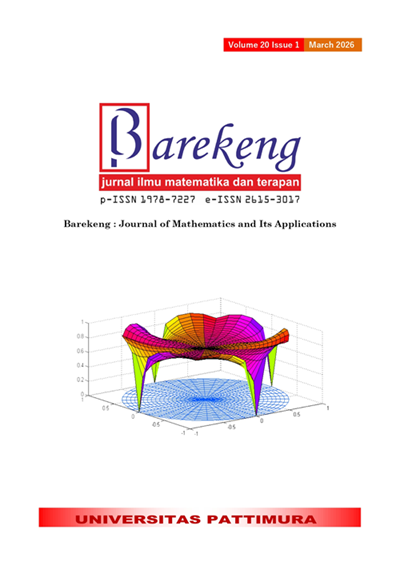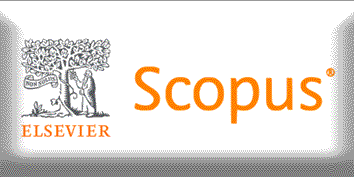PREDICTION OF THE INDONESIA COMPOSITE INDEX (ICI) USING THE ARCH GARCH APPROACH AND THE FOURIER SERIES
Abstract
The Indonesia Composite Index (ICI) is a key indicator of stock market performance in Indonesia, often experiencing high volatility due to various domestic and global economic factors. In recent years, ICI has shown a significant upward trend, influenced by both local and international factors. In 2024, from June to October, the ICI saw a notable increase, reaching its highest value since 2020 at Rp 7,670. Despite fluctuations in stock prices, the rise in ICI reflects a positive outlook for the Indonesian stock market, attracting both domestic and foreign investors. This study aims to predict ICI movements using ARIMA-GARCH and Fourier Series approaches. The ARIMA model is employed to analyze time series data, while the ARCH-GARCH model addresses heteroskedasticity in residual variance. For comparison, the Fourier Series Estimator is applied to capture seasonal patterns in the data. Although ICI volatility is driven by a range of external macroeconomic and geopolitical factors, this study focuses on univariate modeling to evaluate the predictive capability of the index’s own historical movements, without involving exogenous variables. The data used comes from Investing.com. Weekly ICI data from March 2020 to June 2024 is used, split into training and testing sets. The analysis results indicate that the ARIMA-GARCH method provides higher accuracy, with a Mean Absolute Percentage Error (MAPE) of 5% (out-sample), compared to the Fourier Series method, which has a MAPE of 8.57%. This suggests that ARIMA-GARCH is more effective in predicting ICI trends, reflecting its ability to account for volatility and market changes more accurately.
Downloads
References
I. Widiarma, “KEBIJAKAN PENUTUPAN KODE BROKER DAN TIPE INVESTOR PADA LAYAR BURSA DAPAT MENYEHATKAN PASAR MODAL,” Jurnal Ilmiah Manajemen, Ekonomi, & Akuntansi (MEA), vol. 7, no. 2, pp. 1025–1051, Jul. 2023, doi: https://doi.org/10.31955/mea.v7i2.3109.
H. F. Kusnandar, S. Mulyati, and A. S. Rohana, “ANALISIS PERGERAKAN INDEKS HARGA SAHAM GABUNGAN (IHSG) SEBELUM DAN SESUDAH PANDEMI COVID,” EKOMBIS REVIEW: Jurnal Ilmiah Ekonomi dan Bisnis, vol. 11, no. 2, pp. 1113–1120, Jul. 2023, doi: https://doi.org/10.37676/ekombis.v11i2.3834.
R. Andrianto, “IHSG 2023 TAK TERBENDUNG, CATAT REKOR BARU HINGGA SENTUH 7300,” CNBC Indonesia. Accessed: Nov. 28, 2024. [Online]. Available: https://www.cnbcindonesia.com/research/20231230023432-128-501422/ihsg-2023-tak-terbendung-catat-rekor-baru-hingga-sentuh-7300
Investing.id, “IDX COMPOSITE HISTORICAL DATA.,” Investing.id. [Online]. Available: https://id.investing.com/indices/idx composite-historical-data.
B. Jange, “PREDIKSI VOLATILITAS INDEKS HARGA SAHAM GABUNGAN MENGGUNAKAN GARCH,” ARBITRASE: Journal of Economics and Accounting, vol. 4, no. 1, pp. 1–6, Jul. 2023, doi: https://doi.org/10.47065/arbitrase.v4i1.1122.
R. S. Nurfajriyah, D. Harjadi, and F. Adzimatinur, “ANALISIS PERBANDINGAN METODE ARCH DAN GARCH DALAM PERAMALAN INDEKS HARGA SAHAM,” Jurnal Ilmiah Manajemen, Ekonomi Dan Bisnis, vol. 1, no. 2, pp. 148–159, 2024, [Online]. Available: https://journal.feb.uniku.ac.id/jimeb/article/view/70
E. Era, S. W. Rizki, and Y. Yundari, “PEMODELAN INDEKS HARGA SAHAM GABUNGAN DENGAN MODEL REGRESI SEMIPARAMETRIK KERNEL,” Equator: Journal of Mathematical and Statistical Sciences, vol. 1, no. 1, pp. 8–17, Dec. 2022, doi: https://doi.org/10.26418/ejmss.v1i1.57431.
R. Adisetiawan, N. Nuraini, H. T. Putri, and A. Ahmadi, “PERMODELAN GARCH PADA IHSG DAN INDEKS LQ45,” J-MAS (Jurnal Manajemen dan Sains), vol. 6, no. 2, pp. 448–453, Oct. 2021, doi: https://doi.org/10.33087/jmas.v6i2.307.
A. P. Desvina and K. Khairunnisa, “PENERAPAN METODE ARCH / GARCH DALAM MERAMALKAN TRANSAKSI NILAI TUKAR (KURS) JUAL MATA UANG INDONESIA (IDR) TERHADAP MATA UANG EROPA (GBP),” Jurnal Sains Matematika dan Statistika, vol. 4, no. 2, pp. 114–123, 2018.
D. M. AL-Najjar, “MODELLING AND ESTIMATION OF VOLATILITY USING ARCH/GARCH MODELS IN JORDAN’S STOCK MARKET,” Asian Journal of Finance & Accounting, vol. 8, no. 1, pp. 152–167, May 2016, doi: https://doi.org/10.5296/ajfa.v8i1.9129.
N. H. Pajriati, “PENERAPAN METODE AVERAGE BASED FUZZY TIME SERIES LEE UNTUK PERAMALAN HARGA EMAS DI PT. X,” Jurnal Riset Matematika, vol. 1, no. 1, pp. 73–81, Oct. 2021, doi: https://doi.org/10.29313/jrm.v1i1.221.
I. D. N. A. Manuaba, I. B. G. Manuaba, and M. Sudarma, “KOMPARASI METODE PERAMALAN GREY DAN GREY-MARKOV UNTUK MENGETAHUI PERAMALAN PNBP DI UNIVERSITAS UDAYANA,” Majalah Ilmiah Teknologi Elektro, vol. 21, no. 1, pp. 83–88, Jul. 2022, doi: https://doi.org/10.24843/MITE.2022.v21i01.P12.
A. T. R. Dani and N. Y. Adrianingsih, “PEMODELAN REGRESI NONPARAMETRIK DENGAN ESTIMATOR SPLINE TRUNCATED VS DERET FOURIER,” Jambura Journal of Mathematics, vol. 3, no. 1, pp. 26–36, Jan. 2021, doi: https://doi.org/10.34312/jjom.v3i1.7713.
A. T. R. Dani, A. F. Dewi, and L. Ni’matuzzahroh, “STUDI SIMULASI DAN APLIKASI: ESTIMATOR DERET FOURIER PADA PEMODELAN REGRESI NONPARAMETRIK,” in Prosiding Seminar Nasional Matematika, Statistika, dan Aplikasinya, Samarinda, May 2022, pp. 279–288.
H. Nurcahayani, “ESTIMATOR CAMPURAN SPLINE TRUNCATED DAN DERET FOURIER PADA REGRESI NONPARAMETRIK MULTIRESPON,” Doctoral Thesis, Institut Teknologi Sepuluh Nopember, Surabaya, 2022.
N. Chamidah and B. Lestari, ANALISIS REGRESI NONPARAMETRIK DENGAN PERANGKAT LUNAK R. Airlangga University Press, 2023.
Y. Wang, SMOOTHING SPLINES, 1st ed. New York: Chapman and Hall/CRC, 2011. doi: https://doi.org/10.1201/b10954.
F. Fatmawati and A. S. Lubis, “PENGARUH PERILAKU KEWIRAUSAHAAN TERHADAP KEMAMPUAN MANAJERIAL PADA PEDAGANG PAKAIAN PUSAT PASAR KOTA MEDAN,” Jurnal Muhammadiyah Manajemen Bisnis, vol. 1, no. 1, pp. 1–9, Apr. 2020, doi: https://doi.org/10.24853/jmmb.1.1.1-10.
M. Mardianto, “KUMPULAN KARYA ILMIYAH DALAM BENTUK ARTIKEL SEBAGAI BAHAN PENILAIAN MATA KULIAH REGRESI NONPARAMETRIK DAN LITERATURE REVIEW,” 2017.
Copyright (c) 2025 M. Fariz Fadillah Mardianto, Hanny Valida, Farah Fauziah Putri, Doni Muhammad Fauzi, Elly Pusporani

This work is licensed under a Creative Commons Attribution-ShareAlike 4.0 International License.
Authors who publish with this Journal agree to the following terms:
- Author retain copyright and grant the journal right of first publication with the work simultaneously licensed under a creative commons attribution license that allow others to share the work within an acknowledgement of the work’s authorship and initial publication of this journal.
- Authors are able to enter into separate, additional contractual arrangement for the non-exclusive distribution of the journal’s published version of the work (e.g. acknowledgement of its initial publication in this journal).
- Authors are permitted and encouraged to post their work online (e.g. in institutional repositories or on their websites) prior to and during the submission process, as it can lead to productive exchanges, as well as earlier and greater citation of published works.






1.gif)



